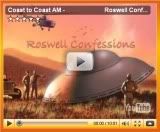To support the space community in better understanding this unprecedented satellite-to-satellite collision, AGI and CSSI have used their software to reconstruct the event. TLEs distributed via Celestrak.com and standard STK conjunction analysis tools have powered CSSIs SOCRATES service since 2004 for regularly performing all-on-all conjunction assessment calculations. Additionally, AGI and CSSI software has been used to help assess the possibility of additional collisions by applying breakup models for debris prediction.
For ALL daily and current UFO news click here

****
 ****
****  ****
****  ****
**** 
..................See each month at a glance on one page
....................Dec...Nov...Oct...Sept...Aug...July...June


























1 comment:
They believe that this debris will be floating around for 10,000 years! Also there is a real possibility that other sateillites could be hit by the debris....
This should concern us, but hardly gets a mention in the press so far.
Post a Comment